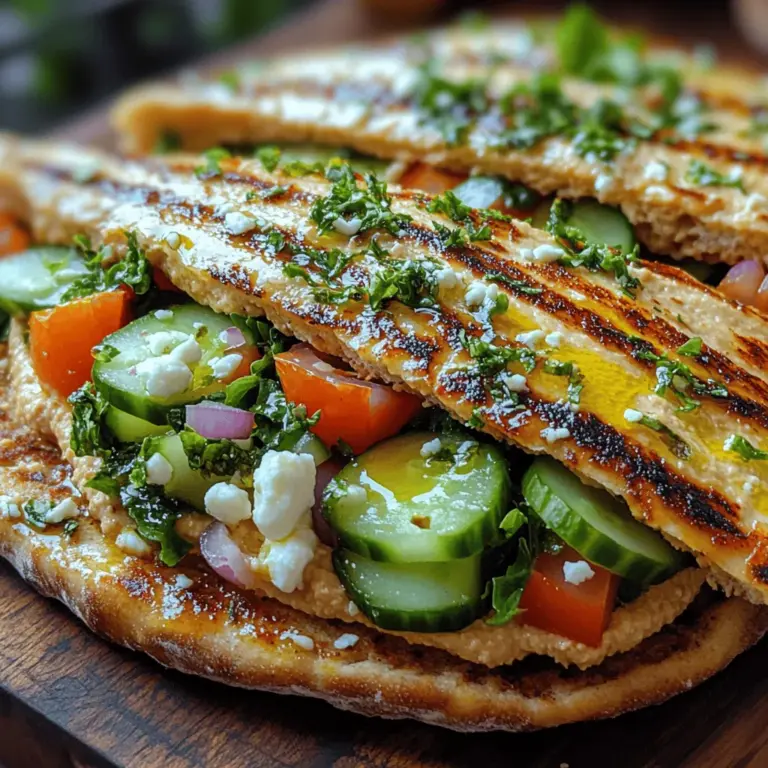The Mediterranean Flatbread Sandwich is a vibrant and nutritious meal that brings the tastes of the Mediterranean right to your table. It is a delightful blend of textures and flavors, combining fresh vegetables, creamy hummus, and tangy feta cheese. This sandwich is not only a true gastronomic delight but also a wholesome option for anyone seeking a quick lunch, a light dinner, or a satisfying snack. Bursting with freshness and color, the Mediterranean Flatbread Sandwich is a versatile dish that can be customized to suit any palate, making it a timeless addition to your culinary repertoire.
The Cultural Significance of the Mediterranean Diet
The Mediterranean diet is celebrated for its emphasis on healthy eating, showcasing a plethora of fruits, vegetables, whole grains, legumes, and healthy fats. This way of eating is deeply rooted in the traditions and cuisines of countries bordering the Mediterranean Sea, such as Greece, Italy, and Spain. Studies have shown that adhering to the Mediterranean diet can lead to numerous health benefits, including reduced risk of heart disease, improved brain function, and better weight management.
As we embark on the journey of creating our Mediterranean Flatbread Sandwich, it is essential to highlight the individual components that make this recipe not only delicious but also nourishing. Understanding the ingredients involved plays a crucial role in appreciating the flavors and health benefits they bring.
Understanding the Ingredients
Exploring Whole Wheat Flatbreads and Pita Bread
When it comes to the base of our Mediterranean Flatbread Sandwich, the choice of bread plays a significant role. Whole wheat flatbreads and pita bread are two excellent options that contribute both flavor and nutrition.
Nutritional Benefits of Whole Wheat vs. White Bread
Whole wheat flatbreads are made from whole grains, meaning they retain the bran, germ, and endosperm of the wheat kernel. This results in a bread that is higher in fiber, vitamins, and minerals compared to its white bread counterpart, which is typically stripped of its nutritional value during processing. The increased fiber content of whole wheat bread aids in digestion and helps maintain steady blood sugar levels, making it a healthier choice overall.
Advantages of Using Pita Bread in Mediterranean Cuisine
Pita bread is a staple in many Mediterranean diets. Its unique pocket structure allows for easy filling and creates a delightful balance of textures when combined with the sandwich’s other ingredients. Light and fluffy, pita bread is ideal for holding in the fresh vegetables and hummus, making every bite a perfect combination of flavors. Additionally, pita is lower in calories than many other bread options, making it an excellent choice for those looking to maintain a healthy diet.
The Role of Hummus in the Sandwich
Hummus is a creamy spread made primarily from chickpeas, tahini, olive oil, lemon juice, and garlic. Its rich texture and nutty flavor make it the perfect complement to the fresh ingredients in our sandwich.
Health Benefits of Hummus
Hummus is not only delicious but also packed with nutritional benefits. It is an excellent source of plant-based protein, which is essential for muscle repair and growth. Additionally, hummus is high in fiber, promoting digestive health and keeping you feeling full longer. The healthy fats from tahini and olive oil also contribute to heart health, making hummus a smart choice for any meal.
Homemade Versus Store-Bought Hummus
While store-bought hummus can be convenient, making your own at home allows for greater control over the flavors and ingredients. Homemade hummus can be easily customized to suit your taste preferences, whether you prefer it spiced with cumin or topped with roasted red peppers. The freshness of homemade hummus often surpasses that of pre-packaged varieties, ensuring that your Mediterranean Flatbread Sandwich is as vibrant as possible.
Fresh Vegetables: The Heart of the Mediterranean Diet
The Mediterranean diet prides itself on the use of fresh vegetables, which not only provide essential nutrients but also add color and flavor to our sandwich.
Importance of Cucumbers and Tomatoes in Mediterranean Dishes
Cucumbers and tomatoes are quintessential ingredients in Mediterranean cuisine. They add a refreshing crunch and juiciness, enhancing the overall flavor profile of the sandwich. Cucumbers are low in calories and high in water content, making them a great hydrating snack. Tomatoes, rich in antioxidants like lycopene, are known for their heart-health benefits and vibrant flavor.
Nutritional Benefits of Mixed Greens
Incorporating mixed greens such as arugula, spinach, and lettuce adds a nutritious boost to our sandwich. Arugula is peppery and adds a unique flavor, while spinach is loaded with vitamins A and C, iron, and calcium. Lettuce provides a crisp texture that balances the creaminess of the hummus and feta cheese.
The Flavor Profile of Red Onions and Kalamata Olives
Red onions bring a sharp, slightly sweet flavor that complements the other ingredients beautifully. They also contain antioxidants and anti-inflammatory properties. Kalamata olives, with their rich, briny taste, are a staple in Mediterranean dishes. They add depth and a savory element to our sandwich, making them an essential addition.
Feta Cheese: A Mediterranean Staple
Feta cheese is a hallmark of Mediterranean cuisine, known for its crumbly texture and tangy flavor.
The Origins of Feta Cheese in Greek Cuisine
Feta cheese has its roots in Greece, where it has been produced for centuries. Traditionally made from sheep’s milk, feta is a protected designation of origin (PDO) product, meaning that true feta must come from certain regions in Greece. Its unique flavor profile varies depending on the milk used and the aging process, giving it a distinct character that enhances our Mediterranean Flatbread Sandwich.
Nutritional Aspects of Feta and Its Unique Flavor
Feta cheese is lower in fat and calories compared to many other cheeses, making it a healthier option for those looking to enjoy dairy. It is also rich in calcium, protein, and vitamins, providing a nutritious boost to the sandwich. The tangy and salty flavor of feta pairs harmoniously with the fresh vegetables, hummus, and whole wheat bread, creating a balanced and satisfying meal.
Preparation Steps for the Mediterranean Flatbread Sandwich
Creating the perfect Mediterranean Flatbread Sandwich is all about preparation. Each step is crucial to ensuring that the flavors come together beautifully.
Preparing the Vegetables: A Fresh Approach
The first step in making your Mediterranean Flatbread Sandwich is to prepare the vegetables. Choosing the freshest produce will enhance the flavor and nutritional value of your sandwich.
Detailed Guidance on Selecting and Chopping Vegetables
When selecting cucumbers and tomatoes, opt for firm, unblemished specimens. For cucumbers, look for ones that are dark green and have a smooth skin. For tomatoes, choose ones that are ripe but not overly soft. To prepare the vegetables, wash them thoroughly under running water. Slice the cucumbers into thin rounds or half-moons, depending on your preference. For the tomatoes, remove the stem and cut them into wedges or dice them into small cubes for easy layering.
Tips for Maximizing Freshness and Flavor in Veggie Preparation
To keep your vegetables fresh, consider chopping them just before assembling your sandwich. If you need to prepare them in advance, store them in an airtight container in the fridge to maintain their crispness. For an added flavor boost, sprinkle a pinch of salt on the chopped vegetables and let them sit for a few minutes. This will enhance their natural flavors and help release some of their juices, making them even more delicious.
Spreading the Hummus: Techniques for Even Distribution
Once your vegetables are prepped, it’s time to spread the hummus on your flatbread. This step is crucial for ensuring that every bite is flavorful and satisfying.
Techniques for Spreading Hummus Effectively on Flatbreads
Using a spatula or the back of a spoon, take a generous scoop of hummus and spread it evenly across the surface of the flatbread. Start from the center and work your way outward, ensuring that the hummus reaches the edges. This will create a uniform layer that allows for each ingredient to stick and enhances the overall taste of the sandwich.
Flavor Variations of Hummus to Consider
To add a personal touch, consider experimenting with different flavors of hummus. Roasted garlic, sun-dried tomato, or spicy harissa hummus can elevate your sandwich to new heights. You can also add fresh herbs like parsley or cilantro to your hummus for an extra burst of flavor.
Layering the Fillings: Building Flavor and Texture
The final step in preparing your Mediterranean Flatbread Sandwich is layering the fillings. This is where the magic happens as you build a delicious combination of flavors and textures.
Layering for Optimal Taste and Texture
Start by placing your sliced cucumbers and tomatoes on top of the hummus layer. Follow with a handful of mixed greens, ensuring that each bite will have a mix of flavors. Next, sprinkle on the chopped red onions and Kalamata olives for a touch of savory goodness. Finally, crumble the feta cheese on top, allowing its tangy flavor to permeate through the other ingredients.
By carefully layering each component, you create a cohesive sandwich that balances flavors and textures, ensuring that every bite is a delightful experience.
In the next part of this article, we will dive deeper into tips for customizing your Mediterranean Flatbread Sandwich, as well as answers to common questions about this delicious recipe. Stay tuned to discover more about how to make this dish truly your own!

Suggestions for Layering Ingredients for Optimal Taste
When creating a Mediterranean flatbread sandwich, the order in which you layer your ingredients can significantly impact both the flavor and the overall texture of the sandwich. Start with a base layer of spread, which can be hummus, tzatziki, or a flavorful olive tapenade. This not only adds moisture but also helps to prevent the bread from becoming soggy.
Next, add your vegetables. Consider using a combination of fresh greens like arugula or spinach, along with sliced cucumbers, juicy tomatoes, and crisp bell peppers. These ingredients provide a refreshing crunch and balance the richness of the spreads and proteins.
If you are including a protein—such as grilled chicken, lamb, or falafel—place it on top of the vegetables. This layering technique not only keeps the sandwich from becoming top-heavy but also allows the flavors to meld beautifully. Finally, finish with a sprinkle of feta cheese or olives for a salty kick, and drizzle with olive oil or a splash of balsamic vinegar to enhance the taste.
The Importance of Ingredient Balance and Presentation
Achieving a harmonious balance of flavors and textures is essential in any sandwich, especially a Mediterranean flatbread sandwich. The combination of creamy spreads, crunchy vegetables, and savory proteins creates a delightful eating experience. It’s crucial to consider the proportions of each ingredient; too much of one element can overpower the others. A good rule of thumb is to maintain a ratio of one part spread, two parts vegetables, and one part protein.
Presentation also plays a vital role in elevating your sandwich. A well-assembled sandwich not only looks appetizing but also makes the meal more enjoyable. Use a variety of colors—bright greens, deep reds, and earthy browns—to create visual interest. When serving, consider cutting the sandwich in half diagonally and placing it on a wooden board or a colorful plate for an appealing display.
Folding and Pressing: Securing Your Sandwich
Best Practices for Folding Flatbreads Without Tearing
Folding flatbreads can be a delicate process, but with a few techniques, you can secure your sandwich without tearing the bread. Start with a fresh, pliable flatbread; stale or dry flatbreads are more likely to crack.
When adding your fillings, avoid overstuffing the sandwich, as this can lead to breakage. Instead, layer the ingredients carefully and leave a small margin around the edges. To fold the flatbread, start by bringing the bottom edge up over the fillings, tucking them in as you go. Then, fold in the sides and continue rolling tightly to secure the filling. If your flatbread is particularly thin, consider using a piece of parchment paper to help hold it together during the folding process.
Techniques for Achieving the Perfect Sandwich Structure
For added stability, consider pressing the sandwich slightly after folding. Use a flat surface or a clean cutting board to gently press down on the sandwich. This action helps to meld the ingredients together and creates a more cohesive structure.
If you’re using a thicker flatbread, such as pita or lavash, you may have the option to cut a pocket into the bread rather than folding it. To do this, carefully slice the bread about three-quarters of the way through, creating a pocket for your fillings. This method can often be easier and less messy, allowing for a more balanced distribution of ingredients.
Heating the Sandwich: To Grill or Not to Grill?
Benefits of Serving the Sandwich Cold Versus Warm
The Mediterranean flatbread sandwich can be enjoyed either cold or warm, depending on your preference. Serving it cold allows the fresh flavors of the vegetables and spreads to shine through, making it a refreshing option, particularly on hot days. Cold sandwiches are also quicker to prepare, perfect for a grab-and-go lunch.
On the other hand, warming the sandwich can enhance the flavors and create a delightful contrast between the warm bread and cool fillings. Heating can also melt cheese, if included, making for a gooey texture that many find irresistible.
Grilling Tips for Achieving the Golden, Crispy Texture
If you decide to grill your sandwich, there are a few tips to ensure you achieve that perfect golden, crispy exterior. Preheat your grill or grill pan to medium-high heat. Lightly brush the outside of the flatbread with olive oil or melted butter to help it crisp up beautifully.
Place the sandwich on the grill, pressing down gently with a spatula or grill press. This encourages even cooking and helps to create those sought-after grill marks. Grill for about 3-5 minutes on each side or until the bread is golden brown and crispy. Keep an eye on it to avoid burning, and adjust the heat as necessary.
Serving Suggestions and Pairings
Complementary Sides to Enhance Your Meal
To elevate your Mediterranean flatbread sandwich, consider pairing it with traditional Mediterranean sides. A refreshing tzatziki sauce is a classic choice, providing a cool, tangy contrast to the richness of the sandwich. Olives, whether Kalamata or green, can add a salty bite that complements the flavors beautifully.
Salads are another excellent accompaniment; a tabbouleh salad, with its fresh parsley and lemony dressing, or a Greek salad with feta, olives, and a drizzle of olive oil can enhance the meal’s overall freshness.
Suggestions for Pairing with Beverages
Beverage pairings can also enhance your dining experience. For a traditional touch, consider serving your flatbread sandwich with a glass of Mediterranean wine. A light, crisp white wine, such as a Sauvignon Blanc or a dry rosé, works well to balance the flavors. Alternatively, herbal teas, such as mint or chamomile, can be refreshing and are in keeping with the Mediterranean ethos of enjoying food and drink mindfully.
Creative Variations of the Mediterranean Flatbread Sandwich
Suggestions for Protein Additions
The versatility of the Mediterranean flatbread sandwich allows for numerous creative variations. For those who enjoy meat, grilled chicken marinated in lemon, garlic, and herbs adds a wonderful depth of flavor. Similarly, lamb, either grilled or roasted, can bring a bold, savory element to the sandwich.
For a vegetarian option, consider adding falafel. These crispy chickpea balls are not only flavorful but also provide a hearty protein source, making your sandwich filling and satisfying.
Vegetarian and Vegan Alternatives to Consider
For a vegan twist on the Mediterranean flatbread sandwich, focus on plant-based proteins like roasted vegetables, chickpeas, or lentils. You can also incorporate slices of avocado for a creamy texture or use hummus as a primary spread. A combination of grilled eggplant, zucchini, and bell peppers can create a hearty filling that rivals any meat-based option.
The Mediterranean Diet: Health Benefits and Cultural Insights
The Mediterranean diet is celebrated not only for its delicious flavors but also for its numerous health benefits. Emphasizing fresh, whole foods, this dietary lifestyle encourages the consumption of fruits, vegetables, whole grains, nuts, seeds, and healthy fats, particularly olive oil. This balanced approach to eating is associated with a lower risk of heart disease, improved brain health, and better overall well-being.
The Mediterranean diet also emphasizes the importance of communal dining and enjoying meals with family and friends. This cultural aspect fosters social connections and mindfulness around food, making it an integral part of the Mediterranean lifestyle.
Exploring Regional Variations of Flatbread Sandwiches
Across the Mediterranean region, various cultures have their own interpretations of flatbread sandwiches. In Turkey, for example, the döner kebab features spiced meats served in flatbread, often accompanied by fresh vegetables and sauces. In Italy, piadina, a type of flatbread, is filled with meats, cheeses, and vegetables, showcasing the region’s rich culinary heritage.
These regional variations highlight the versatility of flatbreads within Mediterranean cuisine, showcasing how different ingredients and preparation methods can create unique and delicious sandwiches.
Conclusion: Enjoying Your Mediterranean Flatbread Sandwich
The Mediterranean flatbread sandwich is more than just a meal; it is an experience that captures the essence of healthy eating and cultural heritage. By combining fresh ingredients, rich flavors, and nutritional benefits, this sandwich exemplifies why the Mediterranean diet is celebrated worldwide. As you enjoy your creation, reflect on the vibrant culinary traditions that inspire such delicious dishes, and consider the simple joy that comes from preparing and sharing good food. Whether you choose to serve it cold, warm, or with a creative twist, your Mediterranean flatbread sandwich is sure to delight your taste buds and nourish your body. Enjoy the journey of flavors and the connection to a rich cultural legacy with every bite.

